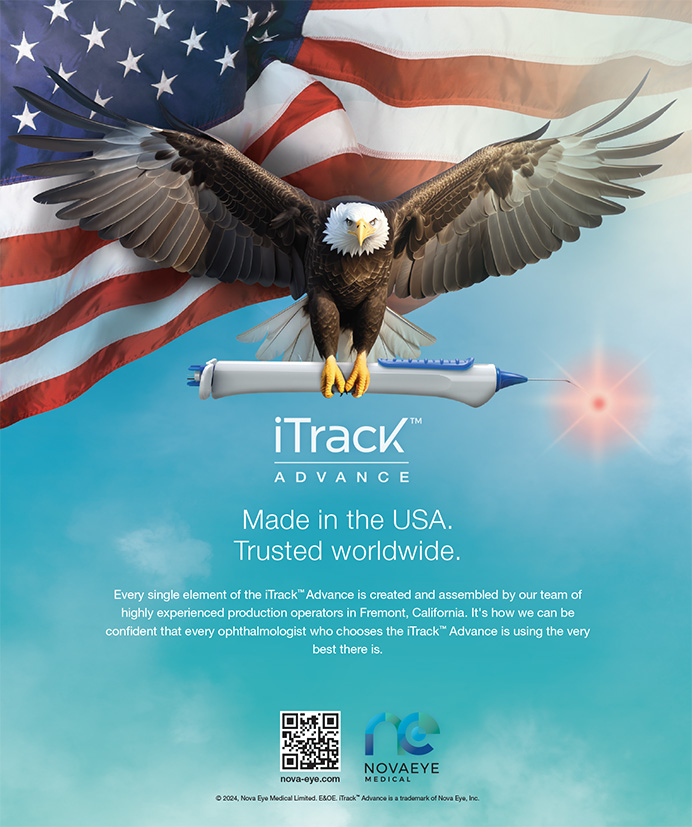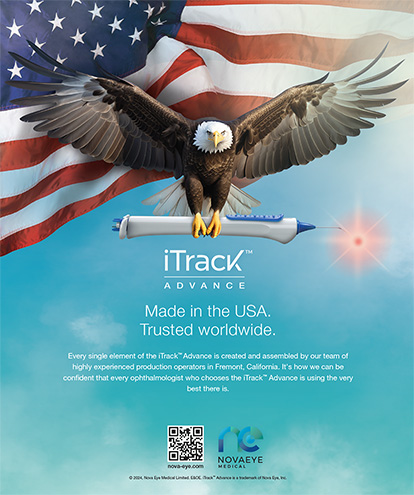I have been creating oval flaps with the iFS Femtosecond Laser (Abbott Medical Optics Inc.) for the past year. The conventional round flap works well, and I have created it many times throughout my 16 years' experience as a LASIK surgeon. However, I believe that oval flaps represent an opportunity to improve the LASIK procedure. They better conform to the natural anatomical shape of the cornea and allow for better alignment of the flap. Moreover, my research shows that the horizontally oval flap matches the horizontally oval ablation pattern that is created for the majority of myopic corrections.
ANATOMICAL COMPATIBILITY
I conducted a retrospective digital video analysis of the mean limbus-to-limbus vertical and horizontal diameters of 10 corneas. As shown in Figure 1, the average outermost horizontal measurement was 12.0 ±0.5 mm, and the average outermost vertical measurement was 11.1 ±0.4 mm. These dimensions demonstrate that the cornea is an 8% horizontal ellipse and that oval flaps are a better anatomical match for the cornea, because they symmetrically fit into the horizontally oval shape of the normal cornea.1 Round flaps can rotate when they are repositioned, causing striae. In contrast, because oval flaps can only fit into one orientation, the possibility of rotation is eliminated and ensures perfect alignment.
Round flaps invade a greater degree of peripheral vital lamellar fibers and nerves superiorly and inferiorly compared with oval flaps, which preserve peripheral fibers and nerves symmetrically (Figure 2).2 Also, fewer cuts are made vertically on the cornea with oval flaps. Because it is equidistant to the limbus from all locations, an oval flap lends itself to more symmetrical healing than a round flap.2
The hinge can be made along the long axis of an oval flap. This creates a wider hinge and better exposure of the stromal bed compared with round flaps (Figure 3). Plus, with an oval flap, the hinge need not be ablated.2
ASTIGMATIC ORIENTATION
An oval flap is a good anatomical match for the horizontally oval shape of the ablation pattern used to correct classic with-the-rule (WTR) astigmatism.3 To assess the orientation and magnitude of astigmatism in the refractive surgery population, I conducted a retrospective analysis of 218,913 eyes from preoperative evaluations performed at TLC Laser Eye Centers between January 2000 and December 2009. I defined WTR astigmatism as plus cylinder within 15º of the 90º axis, against-the-rule (ATR) astigmatism as plus cylinder between 15º of the 180º axis, and oblique astigmatism as oriented in the 60º between WTR and ATR. Of 78,828 eyes with astigmatism greater than 1.00 D, 40% had WTR astigmatism, 20% had ATR astigmatism, and 40% had oblique astigmatism. These data suggest that the vast majority of refractive patients have WTR or oblique astigmatism and require a horizontally oval ablation pattern.3
When I analyzed the orientation of the astigmatism relative to the amount of spherical equivalent (SE) myopia, ATR astigmatism was more common in very low myopes, but WTR astigmatism became more prevalent above about 2.50 D of SE myopia. Approximately 60% of eyes with 7.00 D of SE myopia had WTR astigmatism. The prevalence of ATR astigmatism decreased as the amount of myopia increased. Oblique astigmatism remained constant relative to the amount of SE myopia. Additionally, as the level of astigmatism increased from 1.00 to 5.00 D, the percentage of eyes with WTR astigmatism rose from 37% to 66%. In contrast, the percentage of eyes with oblique astigmatism decreased from 42% to 23%, and the percentage of eyes with ATR astigmatism dropped from 21% to 12%.3
SURGICAL PARAMETERS
I routinely use the iFS Femtosecond Laser to create a flap that is 100 μm deep with inverted 110º side cuts. My preference for making an oval flap is a 5% “oversized” flap set with an 8.2-mm vertical default. I find that the setting provides an 8.6-mm horizontal measurement that fits the average cornea well. I place the pocket in the superior location, as this puts both the pocket and the hinge in the visually insignificant area of cornea masked by the upper eyelid.
CONCLUSION
Based on my research, the vast majority of LASIK patients will greatly benefit from horizontally oval flaps, which correspond to horizontally oval ablation patterns for the treatment of WTR and oblique astigmatism. Oval flaps are anatomically compatible with the cornea, and they allow refractive surgeons to achieve perfect alignment of the flap.
Louis E. Probst, MD, is the national medical director of TLC Laser Eye Centers in Chicago; Madison, Wisconsin; and Greenville, South Carolina. He is a consultant to Abbott Medical Optics Inc. and TLC Laser Eye Centers. Dr. Probst may be reached at (708) 562-2020.
- Probst LE. Corneal and flap dimensions of oval flaps created with the femtosecond laser. Paper presented at: The American Academy of Ophthalmology Annual Meeting; October 21, 2011; Orlando, FL.
- Probst LE. Oval/ellipical flap creation with the femtosecond laser for the treatment of “with the rule” astigmatism. Paper presented at: ASCRS Symposium and Congress; April 21, 2012; Chicago, IL.
- Probst LE. Astigmatic orientation in refractive patients as a benefit of oval LASIK flaps. Poster presented at: The Association for Research in Vision and Ophthalmology Annual Meeting; May 7, 2012; Fort Lauderdale, FL.


